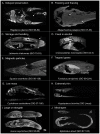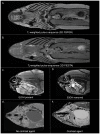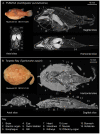The Digital Fish Library: using MRI to digitize, database, and document the morphological diversity of fish
- PMID: 22493695
- PMCID: PMC3321017
- DOI: 10.1371/journal.pone.0034499
The Digital Fish Library: using MRI to digitize, database, and document the morphological diversity of fish
Abstract
Museum fish collections possess a wealth of anatomical and morphological data that are essential for documenting and understanding biodiversity. Obtaining access to specimens for research, however, is not always practical and frequently conflicts with the need to maintain the physical integrity of specimens and the collection as a whole. Non-invasive three-dimensional (3D) digital imaging therefore serves a critical role in facilitating the digitization of these specimens for anatomical and morphological analysis as well as facilitating an efficient method for online storage and sharing of this imaging data. Here we describe the development of the Digital Fish Library (DFL, http://www.digitalfishlibrary.org), an online digital archive of high-resolution, high-contrast, magnetic resonance imaging (MRI) scans of the soft tissue anatomy of an array of fishes preserved in the Marine Vertebrate Collection of Scripps Institution of Oceanography. We have imaged and uploaded MRI data for over 300 marine and freshwater species, developed a data archival and retrieval system with a web-based image analysis and visualization tool, and integrated these into the public DFL website to disseminate data and associated metadata freely over the web. We show that MRI is a rapid and powerful method for accurately depicting the in-situ soft-tissue anatomy of preserved fishes in sufficient detail for large-scale comparative digital morphology. However these 3D volumetric data require a sophisticated computational and archival infrastructure in order to be broadly accessible to researchers and educators.
Conflict of interest statement
Figures





Similar articles
-
Hydroids (Cnidaria, Hydrozoa) from Mauritanian Coral Mounds.Zootaxa. 2020 Nov 16;4878(3):zootaxa.4878.3.2. doi: 10.11646/zootaxa.4878.3.2. Zootaxa. 2020. PMID: 33311142
-
Defrosting the digital library: bibliographic tools for the next generation web.PLoS Comput Biol. 2008 Oct;4(10):e1000204. doi: 10.1371/journal.pcbi.1000204. Epub 2008 Oct 31. PLoS Comput Biol. 2008. PMID: 18974831 Free PMC article. Review.
-
Lessons learned from evaluation of the use of the National electronic Library of Infection.Health Informatics J. 2006 Jun;12(2):137-51. doi: 10.1177/1460458206063809. Health Informatics J. 2006. PMID: 17023404
-
MRI and MRS on preserved samples as a tool in fish ecology.Magn Reson Imaging. 2017 May;38:39-46. doi: 10.1016/j.mri.2016.12.017. Epub 2016 Dec 18. Magn Reson Imaging. 2017. PMID: 27998746
-
Increasing the impact of vertebrate scientific collections through 3D imaging: The openVertebrate (oVert) Thematic Collections Network.Bioscience. 2024 Mar 6;74(3):169-186. doi: 10.1093/biosci/biad120. eCollection 2024 Mar. Bioscience. 2024. PMID: 38560620 Free PMC article. Review.
Cited by
-
Morphology of the Amazonian Teleost Genus Arapaima Using Advanced 3D Imaging.Front Physiol. 2020 Apr 27;11:260. doi: 10.3389/fphys.2020.00260. eCollection 2020. Front Physiol. 2020. PMID: 32395105 Free PMC article.
-
Quantitative assessment of inner ear variation in elasmobranchs.Sci Rep. 2023 Jul 24;13(1):11939. doi: 10.1038/s41598-023-39151-0. Sci Rep. 2023. PMID: 37488259 Free PMC article.
-
Open data and digital morphology.Proc Biol Sci. 2017 Apr 12;284(1852):20170194. doi: 10.1098/rspb.2017.0194. Epub 2017 Apr 12. Proc Biol Sci. 2017. PMID: 28404779 Free PMC article. Review.
-
Micro-computed tomography: Introducing new dimensions to taxonomy.Zookeys. 2013 Feb 4;(263):1-45. doi: 10.3897/zookeys.263.4261. Print 2013. Zookeys. 2013. PMID: 23653515 Free PMC article.
-
Fish in focus: Navigating organ damage assessment through analytical avenues - A comprehensive review.Toxicol Rep. 2024 Nov 28;13:101841. doi: 10.1016/j.toxrep.2024.101841. eCollection 2024 Dec. Toxicol Rep. 2024. PMID: 39717851 Free PMC article. Review.
References
-
- Suarez AV, Tsutsui ND. The value of museum collections for research and society. Bioscience. 2004;54:66–74. doi: 10.1641/0006-3568(2004)054[0066:tvomcf]2.0.co;2. - DOI
-
- Thacker PD. Morphology: The shape of things to come. Bioscience. 2003;53:544–549. doi: 10.1641/0006-3568(2003)053[0544:mtsott]2.0.co;2. - DOI
-
- Winston JE. Archives of a small planet: The significance of museum collections and museum-based research in invertebrate taxonomy. Zootaxa. 2007;1668:47–54.
-
- Giribet G. A new dimension in combining data? The use of morphology and phylogenomic data in metazoan systematics. Acta Zool. 2010;91:11–19. doi: 10.1111/j.1463-6395.2009.00420.x. - DOI
-
- Ziegler A, Ogurreck M, Steinke T, Beckmann F, Prohaska S, et al. Opportunities and challenges for digital morphology. Biol Direct. 2010;5:45. doi: 10.1186/1745-6150-5-45. - DOI - PMC - PubMed
Publication types
MeSH terms
LinkOut - more resources
Full Text Sources

